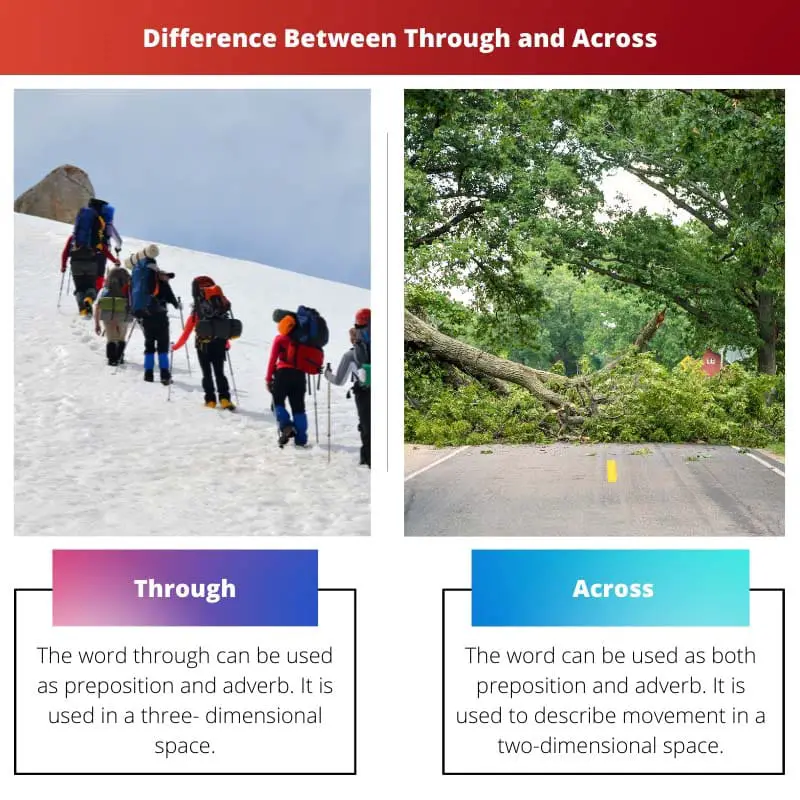“Through” implies movement within or along something, emphasizing the inside. “Across” suggests traversal over a surface or from one side to another, emphasizing the span or width. For example, you walk through a forest, but you swim across a river.
Key Takeaways
- “Through” is a preposition indicating movement from one end of something to the other, passing in between or inside, while “across” is a preposition indicating movement from one side of something to the other, covering the surface or area.
- “Through” suggests a more in-depth or penetrative movement, such as going through a tunnel, while “across” implies movement over or on top of something, like walking across a bridge.
- Both prepositions convey movement and direction but are used to describe different spatial relationships and pathways.
Through vs Across
The preposition “through” can be used as an adverb. It refers to transitioning from one side to the other, used in three-dimensional space. While “across” is used as a preposition as well as an adverb. It is used to describe how a person or thing moves transversely, used in two-dimensional space.

Across describes movement on a particular surface or a two-dimensional space. It is also used both as a preposition and an adverb.
Through is a preposition that indicates completion, and as an adverb, it is used as a comparative or superlative degree.
Examples:
- I love walking through the forest.
- The office is open Monday through Friday.
- She opened coffee shops across the city, and they are very successful.
- We took a boat across the river.
Comparison Table
| Feature | Through | Across |
|---|---|---|
| Movement | Interior: Movement from one side to the other side of something enclosed. | Surface: Movement over or across a flat, two-dimensional surface. |
| Dimensionality | Three-dimensional | Two-dimensional |
| Space enclosed | Yes | No |
| Examples | Walking through a tunnel, jumping through a hoop, swimming through a river | Walking across a street, driving across a bridge, flying across the sky |
| Implied path | More direct, straight line through an enclosed space | Can be any path (straight, curved, diagonal) across a surface |
| Metaphorical usage | Can represent overcoming obstacles, challenges, or difficulties | Can represent progress, transition, or covering a specific distance |
When to Use the Word Through?
The word “through” is a versatile preposition and adverb in the English language. Understanding its various uses is crucial for effective communication.
Usage as a Preposition
1. Movement within an Object or Place
When referring to movement within or inside an object, place, or substance, “through” is commonly used.
- Example: He walked through the crowded marketplace.
2. Completion or Conclusion
“Through” indicates completion, fulfillment, or reaching the end of a process.
- Example: She persevered and succeeded through hard work.
3. Means of Communication or Medium
It is used to express communication using a particular medium.
- Example: We stay connected through regular emails.
Usage as an Adverb
1. Denoting Passage or Duration
As an adverb, “through” can signify the passage of time or the duration of an action.
- Example: The team worked tirelessly through the night to meet the deadline.
2. Successfully or Completely
Used to convey successful completion or thorough understanding.
- Example: They made it through the challenging obstacle course.

When to Use the Word Across?
Definition and Usage
- Across is a preposition and adverb that indicates movement from one side to another or traversal over a surface.
- It implies moving over the width or expanse of something, a physical space or surface.
Spatial Context
- Geographical Boundaries: Use “across” to describe movement from one geographical location or region to another.
- Example: “She traveled across Europe to reach her destination.”
- Physical Distance: Employ “across” when referring to moving from one point to another that is not directly adjacent.
- Example: “The bridge extends across the river, connecting the two banks.”
Figurative Context
- Span or Range: Use “across” to describe a range or spectrum of items or ideas.
- Example: “The issue of climate change cuts across political boundaries.”
- Coverage or Inclusivity: Employ “across” to convey something that applies broadly or inclusively.
- Example: “The message resonated across all age groups.”
Comparative Usage
- Contrast with “Through”: While “across” emphasizes traversal over a surface or from one side to another, “through” implies movement within or along something, emphasizing the inside.
- Example: “He swam across the lake but walked through the forest.”
Additional Notes
- Idiomatic Expressions: “Across” is also used in various idiomatic expressions and phrases.
- Example: “They reached an agreement across the table.”

Main Differences Between Through and Across
- Through:
- Implies movement within or along something.
- Emphasizes the inside or interior.
- Often used for penetration or travel within a medium.
- Example: “He walked through the tunnel.”
- Across:
- Indicates movement from one side to another or traversal over a surface.
- Emphasizes width, span, or distance.
- Used for crossing over a physical space or reaching the opposite side.
- Example: “They sailed across the ocean.”
- Spatial Context:
- Through: Within or along.
- Across: Over or from one side to another.
- Figurative Context:
- Through: Movement within a process or concept.
- Across: Coverage, inclusivity, or traversal over a range.
- Comparative Usage:
- Through: Often used when movement involves an enclosed space.
- Across: Used when moving over an open surface or traversing a distance.
- Idiomatic Expressions:
- Through: May involve completion or accomplishment.
- Across: Often used to convey inclusivity or a wide reach.
- Example:
- Through: “He walked through the forest.”
- Across: “They hiked across the mountains.”




